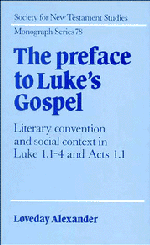Book contents
- Frontmatter
- Contents
- Acknowledgements
- Abbreviations
- 1 The Lucan preface: questions and assumptions
- 2 On the beginnings of books
- 3 Historical prefaces
- 4 Scientific prefaces: origins and development
- 5 Scientific prefaces: structure, content and style
- 6 Luke's preface
- 7 Prefaces in hellenistic Jewish literature
- 8 The social matrix of Luke's preface
- 9 The appropriate form of words for the occasion
- Appendix A Structural analysis of Luke 1.1–4 and selected scientific prefaces
- Appendix B Bibliographical notes on scientific prefaces
- Select bibliography
- Index of scientific authors
- Index of ancient authors and names
- Index of modern authors
- Index of subjects
4 - Scientific prefaces: origins and development
Published online by Cambridge University Press: 15 October 2009
- Frontmatter
- Contents
- Acknowledgements
- Abbreviations
- 1 The Lucan preface: questions and assumptions
- 2 On the beginnings of books
- 3 Historical prefaces
- 4 Scientific prefaces: origins and development
- 5 Scientific prefaces: structure, content and style
- 6 Luke's preface
- 7 Prefaces in hellenistic Jewish literature
- 8 The social matrix of Luke's preface
- 9 The appropriate form of words for the occasion
- Appendix A Structural analysis of Luke 1.1–4 and selected scientific prefaces
- Appendix B Bibliographical notes on scientific prefaces
- Select bibliography
- Index of scientific authors
- Index of ancient authors and names
- Index of modern authors
- Index of subjects
Summary
The place of prefaces in the scientific tradition as a whole
Prefaces, we shall argue, are neither integral nor necessary to the scientific tradition as a whole. But first, what can be said about the tradition as a body of literature?
We have already indicated (above p. 21) the rough area covered by the word ‘scientific’ in this study. It includes for the purposes of literary analysis the ‘esoteric’ treatises of the philosophers as well as the technical treatises of the mathematicians or engineers; it includes astrological herbals and books on dream-interpretation as well as what we would call ‘scientific’ medicine; and it includes even rhetorical schools. It must be clear, then, that we are not talking about a homogeneous collection of writings: the texts belong to different, independent traditions and come into being in diverse ways. Thus there is no equivalance of form between (say) the Hippocratic Epidemics, the Euclidean Elements and the Eudemian Ethics of Aristotle: each scholastic tradition tends to develop and preserve its own favoured means of expression, and has to be understood in its own terms.
In terms of function, however, it is possible to make broader generalizations encompassing the tradition as a whole. Thus the majority of scientific texts fall into one of two broad categories:
(a) Those which reflect more or less directly the oral situation of the lecture hall: such are most of the surviving works of Aristotle, and the musical treatises of Aristoxenus of Tarentum. (Even when the mode of presentation has passed from primarily oral (pupils' or teacher's notes of actual lectures) to primarily written, the natural conservatism of the form itself tends to preserve references to ‘speaking’ and ‘hearing’.)
[…]
- Type
- Chapter
- Information
- The Preface to Luke's Gospel , pp. 42 - 66Publisher: Cambridge University PressPrint publication year: 1993

